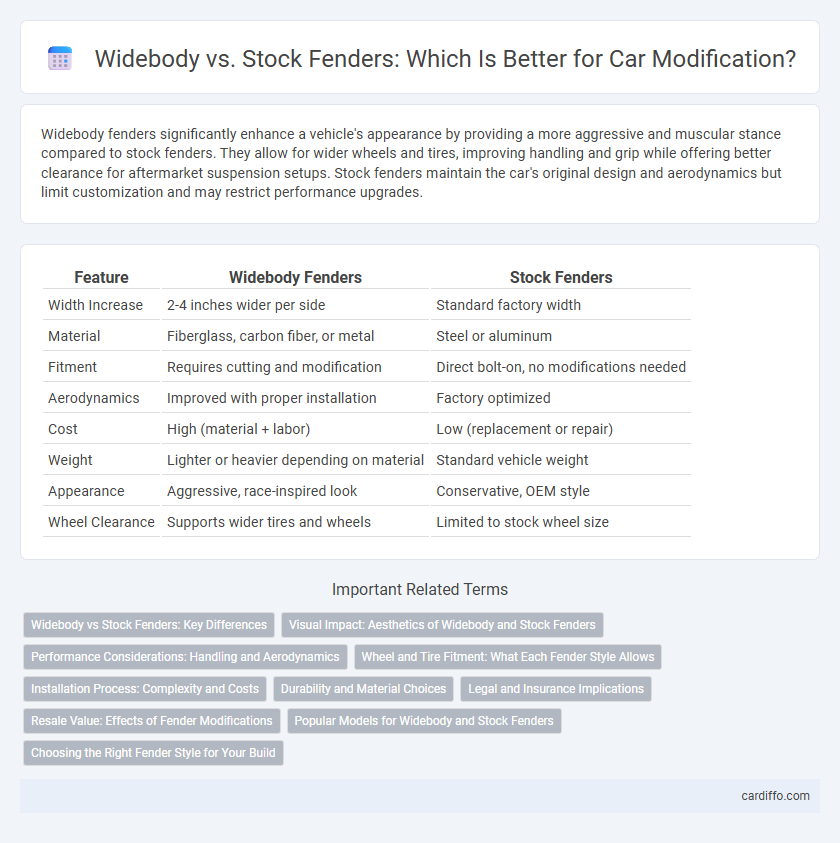Widebody fenders significantly enhance a vehicle's appearance by providing a more aggressive and muscular stance compared to stock fenders. They allow for wider wheels and tires, improving handling and grip while offering better clearance for aftermarket suspension setups. Stock fenders maintain the car's original design and aerodynamics but limit customization and may restrict performance upgrades.
Table of Comparison
| Feature | Widebody Fenders | Stock Fenders |
|---|---|---|
| Width Increase | 2-4 inches wider per side | Standard factory width |
| Material | Fiberglass, carbon fiber, or metal | Steel or aluminum |
| Fitment | Requires cutting and modification | Direct bolt-on, no modifications needed |
| Aerodynamics | Improved with proper installation | Factory optimized |
| Cost | High (material + labor) | Low (replacement or repair) |
| Weight | Lighter or heavier depending on material | Standard vehicle weight |
| Appearance | Aggressive, race-inspired look | Conservative, OEM style |
| Wheel Clearance | Supports wider tires and wheels | Limited to stock wheel size |
Widebody vs Stock Fenders: Key Differences
Widebody fenders extend the width of a vehicle, offering increased tire clearance and an aggressive stance compared to stock fenders, which maintain the manufacturer's original dimensions. This modification allows for wider wheels and tires, enhancing grip and handling, while stock fenders limit customization options but ensure compatibility with factory aerodynamics and components. Widebody kits often require cutting or reshaping the body panels, whereas stock fenders provide a seamless installation with no permanent alterations.
Visual Impact: Aesthetics of Widebody and Stock Fenders
Widebody fenders create a more aggressive and muscular visual impact by extending the car's width, emphasizing its performance-oriented design. Stock fenders maintain the vehicle's original proportions, offering a cleaner and more understated appearance. The choice between widebody and stock fenders significantly affects the car's aesthetic identity and street presence.
Performance Considerations: Handling and Aerodynamics
Widebody fenders improve handling by allowing wider tires that increase grip and stability during cornering, enhancing performance on both street and track. These fenders also facilitate better airflow management around the wheel wells, reducing aerodynamic drag and lift for improved high-speed stability. Stock fenders maintain factory specifications that prioritize balanced aerodynamics and handling for everyday driving but limit the potential for significant performance upgrades.
Wheel and Tire Fitment: What Each Fender Style Allows
Widebody fenders significantly increase the available space for larger wheels and wider tires, enhancing grip and stability on various terrains. Stock fenders maintain factory dimensions, limiting wheel and tire size but preserving original aesthetics and factory clearance levels. Choosing between widebody and stock fenders depends on desired tire width, offset, and vehicle stance preferences.
Installation Process: Complexity and Costs
Widebody fenders require more complex installation compared to stock fenders due to cutting, welding, and precise alignment, often necessitating professional expertise and specialized tools. Stock fenders offer a straightforward bolt-on installation with minimal adjustments, reducing labor time and overall expenses. The increased labor intensity and potential need for custom fabrication in widebody conversions significantly elevate costs beyond standard fender replacements.
Durability and Material Choices
Widebody fenders often utilize reinforced fiberglass or carbon fiber composites, enhancing durability against impacts and road debris compared to stock fenders made from standard stamped steel or thin plastic. The advanced materials in widebody kits provide superior resistance to cracks and warping, making them ideal for aggressive driving and off-road applications. Stock fenders typically offer limited durability and are more prone to dents and corrosion due to their basic material composition.
Legal and Insurance Implications
Widebody fenders often require modifications that may not comply with local vehicle regulations, potentially leading to legal issues such as fines or failed inspections. Insurance companies may increase premiums or refuse coverage if modifications like widebody fenders are not declared or deemed unsafe. Stock fenders generally pose fewer legal and insurance risks, maintaining factory compliance and standard coverage terms.
Resale Value: Effects of Fender Modifications
Widebody fender modifications often reduce a vehicle's resale value due to their niche appeal and potential insurance concerns, while stock fenders maintain broader market demand and higher resale prices. Collectors and buyers typically favor original factory parts for authenticity and ease of repair, ensuring better long-term investment. Vehicles with stock fenders retain higher liquidity in the used car market compared to those with extensive aftermarket widebody kits.
Popular Models for Widebody and Stock Fenders
Widebody fenders are popular on models like the Ford Mustang, Chevrolet Camaro, and Nissan GT-R for their aggressive stance and increased wheel clearance, enhancing both aesthetics and performance. Stock fenders remain favored on vehicles such as the Honda Civic, Toyota Supra, and Mazda MX-5 Miata, preserving original lines and manufacturer aerodynamics. Enthusiasts often choose widebody kits for track-ready modifications while stock fenders appeal to those focused on classic styling and daily drivability.
Choosing the Right Fender Style for Your Build
Widebody fenders provide enhanced tire clearance and aggressive aesthetics, ideal for performance builds requiring wider wheels and improved aerodynamics. Stock fenders maintain factory dimensions, preserving original vehicle lines and minimizing costly modifications or repairs. Selecting the right fender style depends on your build goals, balancing between visual impact, fitment freedom, and budget constraints for optimal results.
widebody vs stock fenders Infographic

 cardiffo.com
cardiffo.com